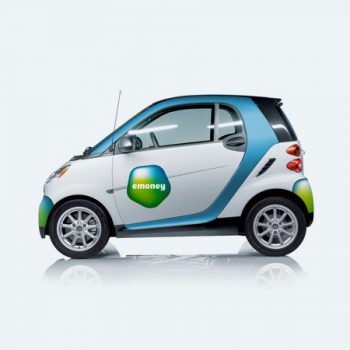Smart phones, smart cities
50% of the world’s current adult population possesses a smartphone, and this number is predicted to rise to 80% by the end of the decade. With great power comes great responsibility, and nowadays, when most people are walking around with what would have passed as a supercomputer just a few decades ago, life in our cities needs to adapt in drastic new ways to the changes — both good and bad.
Smartphone lanes in US & China
Practice safe text in safe areas
Distracted walking. That’s the name of the phenomenon when you are moving about eyes-on-the-screen, oblivious to the everyday dangers and obstacles of a city — moving vehicles, other pedestrians, lampposts…
The first experiments in what might be a remedy to this problem have already cropped up in several places around the world, most notably in Washington DC and Chongqing, China in the form of pedestrian lanes designated for inattentive smartphone users.
While these may not be the most serious “solutions”, but rather something from the realm of social experiments, nevertheless the problem is quite real in the eyes of many organizations. This video by the AAOS (American Academy of Orthopaedic Surgeons) for instance portraits distracted pedestrians as a real menace to society, even going so far as to label them “digital deadwalkers”.
Perhaps a dedicated lane would indeed alleviate some of the problems associated with distracted walking, although it remains to be seen if such lanes would be noticed at all by the target audience, considering the nature of the problem. But if all else fails, then perhaps it’s not just your phone that could benefit from a bumper cover.
Traffic lights reimagined
Keep those lights where I can see them!
Smombie. This other new term — that was recently voted “youth word of the year” in Germany — describes people blankly staring into the screens of their smartphones, oblivious to the world around them.
Bumping into other people on the street is bad enough, but the situation around distracted walking becomes more serious when it comes to crossings involving cars, trains and other vehicles. The German municipality of Augsburg took action after a few smombie-related incidents occurred at some of its local tram crossings, and installed new traffic lights — at ground level.
These new LED light installations are also currently in test phase, but will be rolled out to other cities if they prove to be a successful solution to the smombie problem. After Augsburg, Cologne has also implemented the new “boden ampeln” (ground traffic lights) at three tram crossings in the city.
But it wouldn’t be a truly “smart” solution if there wasn’t an app for it, and of course there is one. Watch Out! is an app that is currently available for Germany, and it uses a system of beacon transmitters placed at potentially dangerous areas, such as crossings. Users mark hazardous areas on the map, and the Watch Out! team places a beacon there. Once the app is installed, the user will receive a signal whenever close enough to one of the beacons, with the signal blocking all app activity on the phone and displaying a warning message forcing the user to pay attention to the surroundings.
Getting around the city
Planet of the apps
While we’re on the subject of apps, and having mentioned the problems emerging at the crossroads of traffic and smartphone use, let’s also talk about the benefits arising from carrying supercomputers in our pockets.
Far surpassing the number of apps meant to remedy the problems with smartphones are apps that take full advantage of our highly connected infrastructure. Public transport, parking, taxi services, intra-city bicycle systems — the solutions are numerous. Paying for the fare, navigating your way around the city, locating parking space, avoiding traffic jams, and many other activities have been favourably influenced by the advent of a highly ubiquitous mobile information network.
And while we can all certainly feel these advantages in our daily lives, the added bonus here is that this “upgrade” comes at to no expense to the city itself. There is no need for the infrastructure to adapt to these new technologies, the particular municipalities simply have to “play along”, and participate in the playing field already laid out for them by telecommunication and software enterprises.
Reporting road damage via apps
When the little brother is watching
One such initiative by the UK government is taking advantage of the omnipresence of smartphones with an app called Fill That Hole, which facilitates reporting of potholes on the roads, speeding up the repair process. With the help of this program municipalities can mitigate the problem of potholes, leading to an improvement in city infrastructure.
Other places have also been implementing these reporting solutions, for example Boston with their app StreetBump, or the spanish city of Logroño, using an integrated city guide that features road damage reports.
The Spanish in general seem to be foreseeing a future where all the “city-related apps” such as the ones mentioned above could become too many to keep up with, and are investing in integrated solutions right away. Apps such as the Barcelona al mòbil or Santander’s Pulso de la Ciudad not only allow users to report incidents or post suggestions to local authorities, but also provide real-time information on beaches, public transport, public bikes availability, etc.
Charged cities
Power to the people
It’s clear that smartphones offer a very rich, new way of interacting with and integrating into a city’s life, and the emerging solutions are only to become more numerous with time. In turn, the cities can facilitate the advancement of these new technologies by adding new functionalities to their existing infrastructures.
A common gripe of most smartphone users has to do with the limited battery capacities of their devices, and this is one area where an upgrade in a city’s infrastructure can greatly improve on the situation.
Public charging booths are appearing in cities all over the world as of late — hailing from Dublin is the Fastcharge project, offering 20 minutes worth of charge for 1 Euro, and not far away geographically is Gotwind’s Street Charger, which works on solar energy and can charge up to 20 devices at once.
Charging mobile devices with renewable energy is an especially smart solution of course, since it comes at no cost not only for the end user, but the environment also. NRG Street Charge is one such project for example, and it has already been successfully adopted in New York City as part of an initiative by AT&T. Soofa “smart urban furniture” is another example, and this solar charging bench is also present in several cities in North America.
As technologies march along forward, so will our environments — this part is inevitable. Let’s just hope that along with the development of our smartphones, our cities will be able to keep up with the pace in becoming smarter themselves.
Well, it’s either the cities or us… Probably the cities though.







